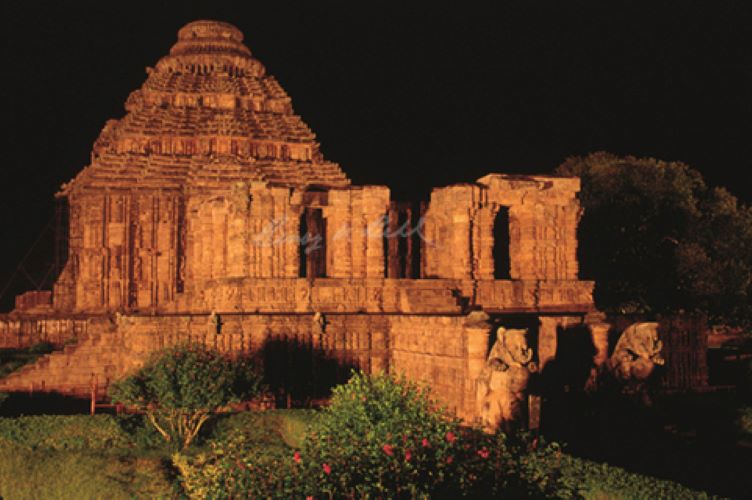Benoy K Behl
In the 13th century, in Odisha on the eastern coast of India, was made a grand temple dedicated to Surya, the Sun. It was the tallest and most magnificent temple made in India, the climax of 800 years of building structural stone temples. It was built by King Narasimhamahadeva I of the Ganga dynasty.
The great temple at Konark was made essentially according to the regional style which had been developed, with a dramatic difference. The temple tower or deul and the hall or jagmohan were conceived as a giant chariot of the Sun. Twenty-four large wheels, 12 on each side, representing the twelve months of the year, were made for the ratha or chariot. Seven horses were made in front, who pull it forward at a spirited gallop.
The deul or tower of the temple originally stood over 200 feet tall, higher than any other temple in India. The hall or jagmohan still stands over 130 feet tall.
Since earliest times, the life-giving vital and qualities of nature have been adored at stupa and temple sites in India. The worship of Surya is as ancient as that of any other deity. Temples to the Sun god stand at Martand in Kashmir, Modhera in Gujarat, Ranakpur in Rajasthan and at many other sites.
The jagmohan or hall of the temple and the deul or tower are built on the same platform. Against the sides of the platform and the staircase in front are made the giant wheels of the great chariot for the Sun. These stand over ten feet high and lend the quality of an epic imagination to the monument. It is the ratha or chariot which draws Surya, in his daily journey across the blue sky. The giant wheels remind us of the grandeur which is in all of creation. The magnificence of divinity which we can awaken within us.
The jagmohan stands about 130 feet tall. The roof is made in the traditional Odisha style. It is a stepped pyramidical form known as a pidha roof. On the terraces of the different levels of the roof are made some of the finest figures at Konark. Shiva is made in his wrathful form as Bhairava, guarding the temple from evil forces. On either side are beautiful musicians, who herald the passage of the Sun, across the skies. They are carved out of chlorite, which is both conducive to fine carving and lasts very well.
Unfortunately, the main and tallest structure of the temple, its grand tower, has collapsed. The sanctum is in ruins.
Around the tower of the temple are made the Parsva Devatas, images most closely related to the main deity in the shrine.
On the south, a larger than life-sized Surya stands majestically on his chariot. His charioteer is Aruna, the dawn. Surya is the only Indian deity to be depicted with boots, which are not an indigenous tradition. The king and his family priest are seen kneeling below the deity.
In ancient times, the art of stupas and cave temples was sponsored by the people. It was farmers, fishermen, traders, housewives, monks and nuns who paid for the making of the sculptures and gateways. The purpose of art was to take us to eternal themes, away from the noise and clamour of the material world around us. The aim was to lose the ego and the concern for the self. Therefore, ephemeral personalities, including of kings, were not depicted.
From the 8th century onwards, we have seen a shift. There is now an emphasis on grandeur and the depiction of regal power and splendour, through the making of great temples. We have also seen the emergence of images of the king, in sculpture and in painting.
The Sun temple at Konark represents the high point of monumentality and splendour in the tradition of temple building. It also celebrates the activities and life of the king, as never before in temples. The niches of the sanctum and of the jagmohan were originally filled with many images of the king. He is seen practicing archery, with admirers looking on. He is seen at a festival or in a leisurely moment, sitting on a swing.
The temple celebrates all of life around, with the divinity at the centre of it all. It also places the king very close to the focus at the centre and celebrates his life and greatness. The King Narasimhamahadeva I is seen worshipping the Shivalinga, Vishnu and Surya.
Colossal pairs of animals originally guarded the stairways on all sides of the jagmohan. The ones on the east are now placed before the entrance to the Bhoga Mandapa. The ferocious lions rear majestically above the elephants crushed below them. They awaken within us the attitude of fearlessness, with which we are to face the demons of ignorance who block our path towards knowledge. Inspired by these fearless creatures, who represent the potential within us, we proceed into the temple.
The Bhoga Mandapa is at the entrance to the temple complex. The temple represents the entire cosmos. Here, where we have just come into the sacred grounds, we are surrounded by a world of effusive forms. They represent the joy of life. In Indic belief, the path to realisation is one which leads to bliss. Musicians and dancers greet us here in the Bhoga Mandapa. In modern times, the lost form of the classical dance of Odissi was revived largely through the study of the dance movements portrayed here.
Under the Glimpses of Culture series, India Habitat Centre presents an online talk and screening of the film ‘Konark: The Sun God’s Chariot’ produced by Benoy K Behl for Doordarshan on October 26, 6pm
